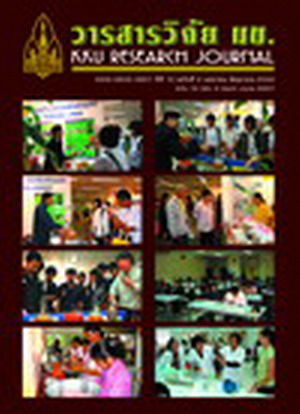Rate of Nicotine Addiction and Cigarette Smoking group Behavior of people Enrolled in the Program of 'Reduce, Abstain, and Give Up Cigarettes for The Queen's 72nd Birthday' in Khon Kaen.(Thai)
Main Article Content
Abstract
This research was conducted in the form of a descriptive study. The aim of this study was to identify the
rate of nicotine addiction, rate of cigarette smoking, and to gauge knowledge with regard to the dangers of
cigarette smoking and the effects it has on the health of the group of people who enrolled in the program
'Reduce, Abstain, and Give Up Cigarettes for The Queen's 72nd Birthday' in Khon Kaen during the period June
2003 to September 2004. The tool used in conducting the research was in the form of self - report question-
naires. The result of this research will be used as a means of carrying out an efficient program designed to
prevent and control cigarette smoking amongst other groups of people in the future.
At the completion of the study, results were used to draw conclusions about the total population of 408
people which were all made up of men. The rate of smoking was 59.60 per 100, and the rate of nicotine
addiction (addicted to cigarettes) was 59.60 per 100. From this number one was able to divide the group into
3 separate target groups depending on the level of nicotine addiction. The group that had little nicotine addiction amounted to 140 people as calculated to be 57.61 per 100 people. The group that had an average nicotine addiction amounted to 64 people or calculated to be 26.34 per 100, and the group that had the highest nicotine addiction was represented by 39 people or 16.05 of 100 people. On the topic of the knowledge of the dangers that cigarette smoking has to the health of the people who were enrolled in the program, it was found that everyone in the target group (100 per 100) acknowledged that smoking may contribute to the development of harmful diseases such as lung disease, cancer, emphysema, heart disease, impotence, and coronary artery heart disease. Of the target group, 89.71 per 100 had the desire to give up smoking, 50.92 per 100 answered with certainty that they wanted to give up cigarette smoking, whilst the remainder were not certain. 56.38 per 100 would gladly receive treatment from a medical facility.
Article Details
How to Cite
Taksinachanekij, S. (2017). Rate of Nicotine Addiction and Cigarette Smoking group Behavior of people Enrolled in the Program of ’Reduce, Abstain, and Give Up Cigarettes for The Queen’s 72nd Birthday’ in Khon Kaen.(Thai). Asia-Pacific Journal of Science and Technology, 12(2), 173–182. retrieved from https://so01.tci-thaijo.org/index.php/APST/article/view/82955
Section
Research Articles
References
-


